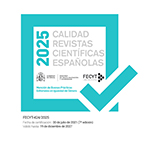Submissions
Submission Preparation Checklist
As part of the submission process, authors are required to check off their submission's compliance with all of the following items, and submissions may be returned to authors that do not adhere to these guidelines.-
Submitting an article to this journal implies the acceptance of the Declaration of Originality and Authorship.
Download file - The submission file is in OpenOffice, MicrosoftWord, RTF or WordPerfect document file format.
- All the references of the text follow the MLA style, 8th edition.
- The text adheres to the stylistic and bibliographic requirements outlines in the Author Guidelines, which is found in "About the Journal".
- Where available, URLs for the references have been provided.
- Where available, DOIs have been included.
- If submitting to a peer-reviewed section of the journal, the instructions in ‘Ensuring a Blind Review’ have been followed.
- It is required that the Author Declaration be signed and scanned by all authors and attached when you send your article.
- Submit a signed copy of the Transfer Copyright Agreement when you send your article.
- The article and the other required documents will be sent through the OJS system, by clicking on the link "make a new submission" on the top of this page.
- Make sure you add your ORCID ID to your Amaltea profile.
Copyright Notice
Amaltea. Revista de mitocrítica is an open access journal which means that all content is freely available without charge to the user or his/her institution. Users are allowed to read, download, copy, distribute, print, search, or link to the full texts of the articles in this journal without asking prior permission from the publisher or the author. This is in accordance with the BOAI definition of open access."Full-text articles published in Amaltea. Revista de mitocrítica are open-access and published under a CreativeCommons License Attribution-NonCommercial-NoDerivatives 4.0 International (CC BY-NC-ND 4.0) http://creativecommons.org/licenses/by-nc-nd/4.0/deed.en. Reproduction, distribution or public communication of these articles with commercial purposes requires the Editor’s prior written. Redistribution for academic purposes is permitted, provided that the source and authorship are properly acknowledged, and that the journal is credited with the first publication, by adding a link to the journal's official URL. If available, the DOI of the article in question should also be included.
Privacy Statement
Basic information on treatment data protection: Publications Service
| Controller | Vicerrectorado Cultura y Deporte y Extensión Universitaria, +info |
| Purpose | Dissemination and sale of UCM’s publishing/ billing and shipping of publications +info |
| Legitimacy | Mission in public interest; execution of a contract +info |
| Recipients | No data will be transferred to third parties, except legal obligation +info |
| Rights | Access, rectify and erasure data, as well as other rights, explained in the additional information +info |
| Additional information | You can find more detailed information on our website: https://www.ucm.es/file/info- |












